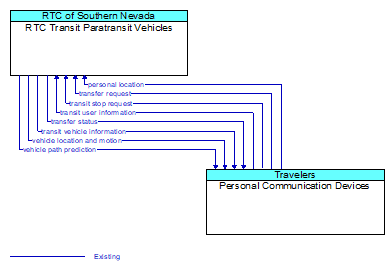Interface: RTC Transit Paratransit Vehicles - Personal Communication Devices

Architecture Flow Definitions
personal location (Existing) Applicable ITS Standards
The current location (latitude, longitude, and elevation) reported by the personal information device
transfer request (Existing) Applicable ITS Standards
A traveler request for a transfer between transit routes, services, or modes. The request may also include preferences such as a need for extra connection time or connection protection in the event of a delay.
transfer status (Existing) Applicable ITS Standards
Information indicating whether a requested transfer can be confirmed including specific information about the connection including fare payment information. Real–time updates are provided if the transfer status changes up to and including a reminder just prior to the transfer. In the event that a requested transfer is not feasible, alternatives including other transit, rideshare, and taxi options are provided.
transit stop request (Existing) Applicable ITS Standards
Notification that a transit stop has been requested by a transit user at a roadside stop. This flow identifies the route, stop, and the time of the request.
transit user information (Existing) Applicable ITS Standards
Information about individual transit users boarding a transit vehicle, used to track a user's progress on a scheduled transit trip.
transit vehicle information (Existing) Applicable ITS Standards
Information about the transit vehicle route and stops, including current location along the route and next stop.
vehicle location and motion (Existing) Applicable ITS Standards
Data describing the vehicle's position, heading, speed, acceleration, transmission, steering wheel angle, braking status, size information, and trajectory.
vehicle path prediction (Existing) Applicable ITS Standards
The predicted future vehicle path of travel. This flow includes an indication of the future positions of the transmitting vehicle that can be used by receiving vehicles to support coordinated driving manuevers and enhance in–lane and out–of–lane threat classification.